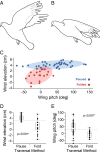Pigeons trade efficiency for stability in response to level of challenge during confined flight
- PMID: 25733863
- PMCID: PMC4371974
- DOI: 10.1073/pnas.1407298112
Pigeons trade efficiency for stability in response to level of challenge during confined flight
Abstract
Individuals traversing challenging obstacles are faced with a decision: they can adopt traversal strategies that minimally disrupt their normal locomotion patterns or they can adopt strategies that substantially alter their gait, conferring new advantages and disadvantages. We flew pigeons (Columba livia) through an array of vertical obstacles in a flight arena, presenting them with this choice. The pigeons selected either a strategy involving only a slight pause in the normal wing beat cycle, or a wings-folded posture granting reduced efficiency but greater stability should a misjudgment lead to collision. The more stable but less efficient flight strategy was not used to traverse easy obstacles with wide gaps for passage but came to dominate the postures used as obstacle challenge increased with narrower gaps and there was a greater chance of a collision. These results indicate that birds weigh potential obstacle negotiation strategies and estimate task difficulty during locomotor pattern selection.
Keywords: Columba livia; cluttered flight; collision; efficiency; stability.
Conflict of interest statement
The authors declare no conflict of interest.
Figures




Similar articles
-
Pigeons produce aerodynamic torques through changes in wing trajectory during low speed aerial turns.J Exp Biol. 2015 Feb 1;218(Pt 3):480-90. doi: 10.1242/jeb.104141. Epub 2014 Dec 1. J Exp Biol. 2015. PMID: 25452503
-
Work loop dynamics of the pigeon (Columba livia) humerotriceps demonstrate potentially diverse roles for active wing morphing.J Exp Biol. 2019 Apr 5;222(Pt 7):jeb195578. doi: 10.1242/jeb.195578. J Exp Biol. 2019. PMID: 30890622
-
Predicting power-optimal kinematics of avian wings.J R Soc Interface. 2015 Jan 6;12(102):20140953. doi: 10.1098/rsif.2014.0953. J R Soc Interface. 2015. PMID: 25392398 Free PMC article.
-
Flapping wing aerodynamics: from insects to vertebrates.J Exp Biol. 2016 Apr;219(Pt 7):920-32. doi: 10.1242/jeb.042317. J Exp Biol. 2016. PMID: 27030773 Review.
-
Bat flight: aerodynamics, kinematics and flight morphology.J Exp Biol. 2015 Mar;218(Pt 5):653-63. doi: 10.1242/jeb.031203. J Exp Biol. 2015. PMID: 25740899 Review.
Cited by
-
Birds invest wingbeats to keep a steady head and reap the ultimate benefits of flying together.PLoS Biol. 2019 Jun 18;17(6):e3000299. doi: 10.1371/journal.pbio.3000299. eCollection 2019 Jun. PLoS Biol. 2019. PMID: 31211769 Free PMC article.
-
Anticipatory Manoeuvres in Bird Flight.Sci Rep. 2016 Jun 8;6:27591. doi: 10.1038/srep27591. Sci Rep. 2016. PMID: 27270506 Free PMC article.
-
Birds both avoid and control collisions by harnessing visually guided force vectoring.J R Soc Interface. 2022 Jun;19(191):20210947. doi: 10.1098/rsif.2021.0947. Epub 2022 Jun 15. J R Soc Interface. 2022. PMID: 35702862 Free PMC article.
-
Flying through gaps: how does a bird deal with the problem and what costs are there?R Soc Open Sci. 2021 Aug 11;8(8):211072. doi: 10.1098/rsos.211072. eCollection 2021 Aug. R Soc Open Sci. 2021. PMID: 34430051 Free PMC article.
-
Gap selection and steering during obstacle avoidance in pigeons.J Exp Biol. 2023 Jan 15;226(2):jeb244215. doi: 10.1242/jeb.244215. Epub 2023 Jan 23. J Exp Biol. 2023. PMID: 36576032 Free PMC article.
References
-
- Sponberg S, Full RJ. Neuromechanical response of musculo-skeletal structures in cockroaches during rapid running on rough terrain. J Exp Biol. 2008;211(Pt 3):433–446. - PubMed
-
- Teyke T. Collision with and avoidance of obstacles by blind cave fish Anoptichthys jordani (Characidae) J Comp Physiol A Neuroethol Sens Neural Behav Physiol. 1985;157(6):837–843. - PubMed
-
- Hagstrum JT. Atmospheric propagation modeling indicates homing pigeons use loft-specific infrasonic “map” cues. J Exp Biol. 2013;216(Pt 4):687–699. - PubMed
-
- Mora CV, Ross JD, Gorsevski PV, Chowdhury B, Bingman VP. Evidence for discrete landmark use by pigeons during homing. J Exp Biol. 2012;215(Pt 19):3379–3387. - PubMed
-
- Wiltschko R, Wiltschko W. Avian navigation. Auk. 2009;126(4):717–743.
Publication types
MeSH terms
LinkOut - more resources
Full Text Sources
Other Literature Sources

